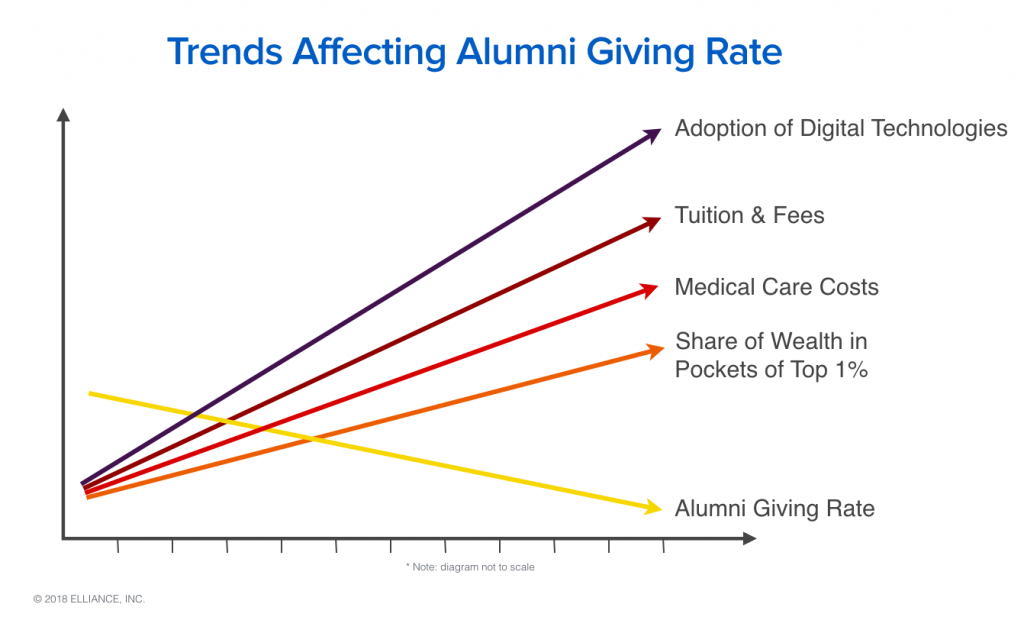| Sep 8, 2018
Reversing The Decline in Alumni Giving Rates
Alumni giving rates have dropped by more than 50% in the last twenty years. Mega-gifts continue to expand while the number of donors has declined primarily because philanthropic support from millennials has decreased. The net impact of all this is that while the total dollars raised has increased, the total number of donors has declined.
These trends begin to make sense when you see the chart below of some recent societal changes.

These micro-trends are reducing alumni giving rates in a unique way: continued increase in tuition and healthcare costs is leaving less money in the pockets of recent alumni; social media is exposing alumni to a variety of new and exciting options for giving; a winner-take-all mindset is concentrating wealth in higher net worth families leaving less money in the hands of middle class and lower income families; colleges are still deploying traditional ask-strategies which are out of touch with the habits of Gen-X, Gen-Y and Gen-Z digital natives.
To combat the decline, we recommend that colleges and universities:
1. Invest in branding.
In the sea of sameness, brands win. For a college, a brand is the reason for its existence, the sum of life-changing interactions between students and faculty, a measure of lives transformed, and its impact on the greater world. Alumni want to belong to a brand that matters, and a tribe that is solving problems of consequence.
Great colleges invest in branding, and refresh their brands periodically to stay relevant. Capital campaigns become a forcing function to revisit and ensure their enduring brand is updated.
2. Cultivate major donor relationships early.
Mighty oaks from little acorns grow. The best time to establish and cultivate a relationship with a major donor is when they are still small, making sustained modest donations for more than a decade, and engaging with the university in their own unique ways. Just as Nike bets on emerging talent, the advancement officers identify, watch and invest in recent alumni with potential. Smart advancement officers ask potential donors to help shape giving priorities.
At the appropriate time in the relationship, senior college team officers should make the personal ask, with all the necessary accoutrements that the occasion demands.
3. Create a culture of sustained giving.
Five things are needed:
- Cultivate alumni engagement with programs commensurate with what they can give: time, treasure and/or talent.
- Develop a model that segments the alumni into a spectrum of likelihood to give based on their history of giving. Send personalized and customized communications to each segment.
- Maintain sustained communications with alumni. Colleges can’t stay dormant for long period of time, show up one day and expect alumni to simply start giving.
- Avoid sending tone-deaf communications, which are insensitive to emotions, motivations and needs prevalent in different stages of life of alumni.
- Deploy social media tactics for annual giving.
4. Invest in communicating the strength of an institution’s reputation.
Alumni need continual assurance that their alma mater is thriving; that the value of their degree is growing; that the tribe they belong to is healthy and flourishing.
The best way to achieve this is to keep alumni and friends informed with a flagship publication that tells high-fidelity stories. The publication should be delivered periodically in print and/or digital format, and the stories should be made productive with Google optimization and social media sharing.
If you are seeking higher education fundraising agencies to grow the endowment of your college, view our higher education marketing capabilities and consider partnering with us.
